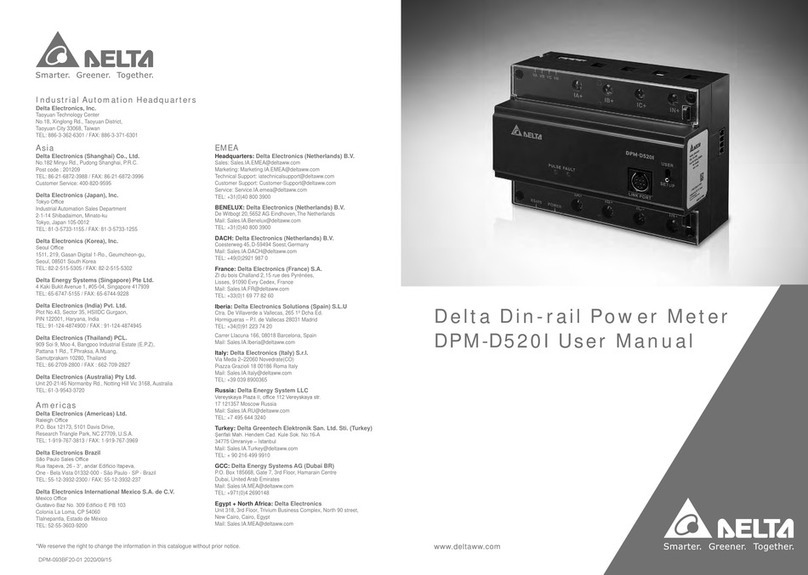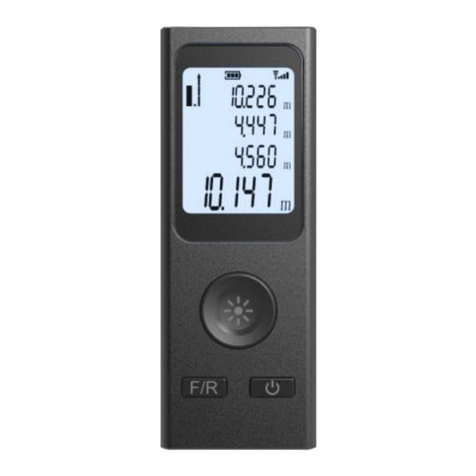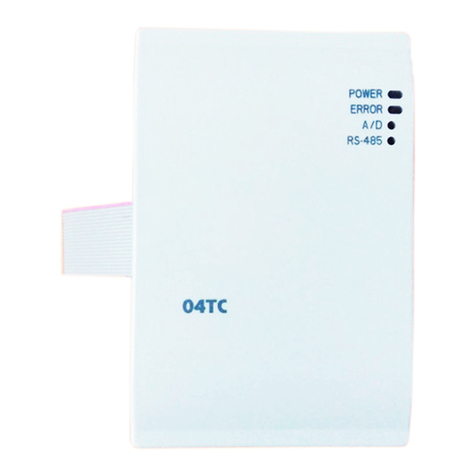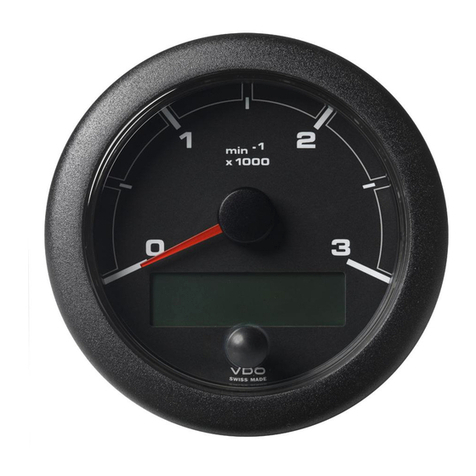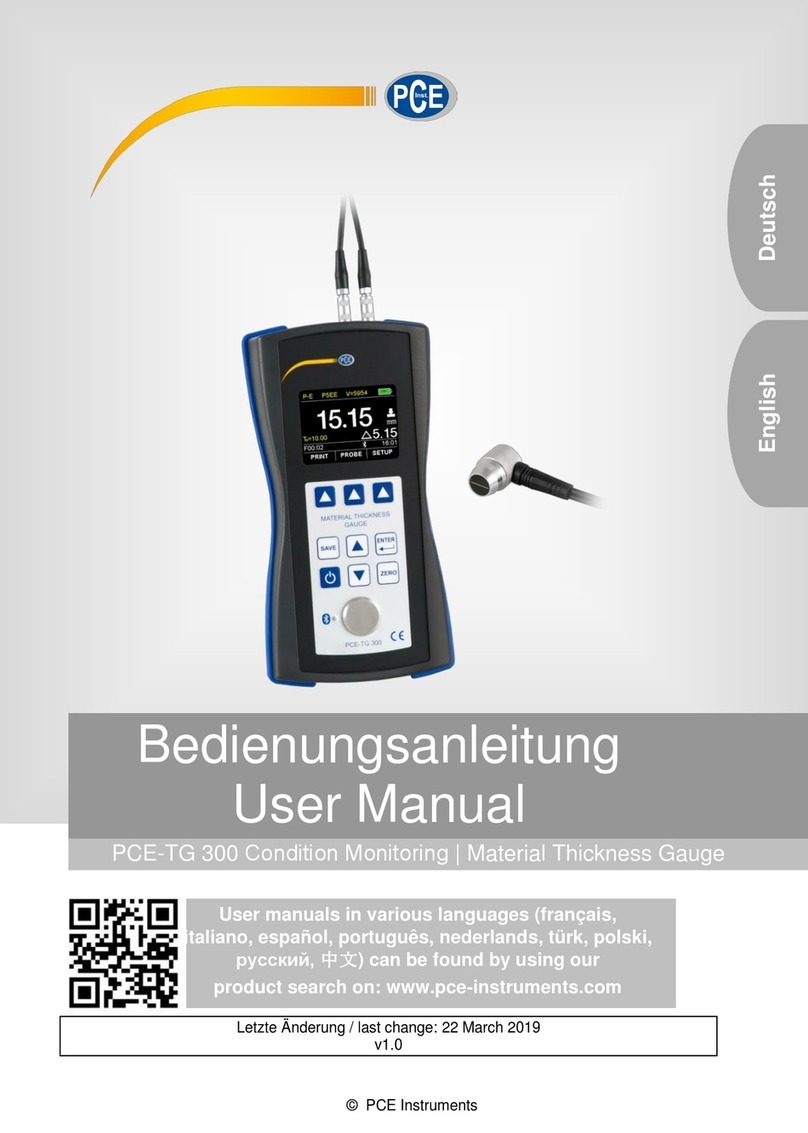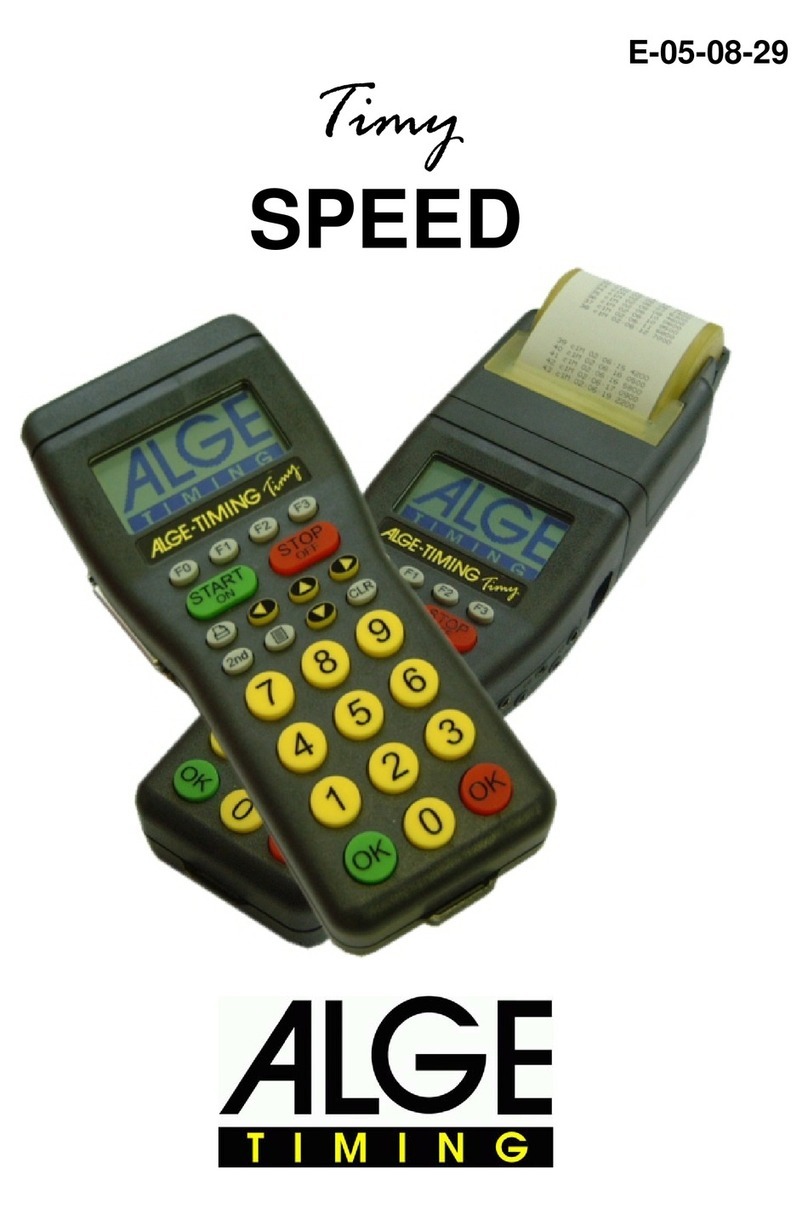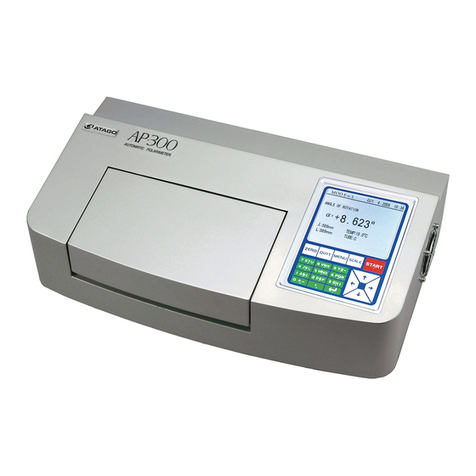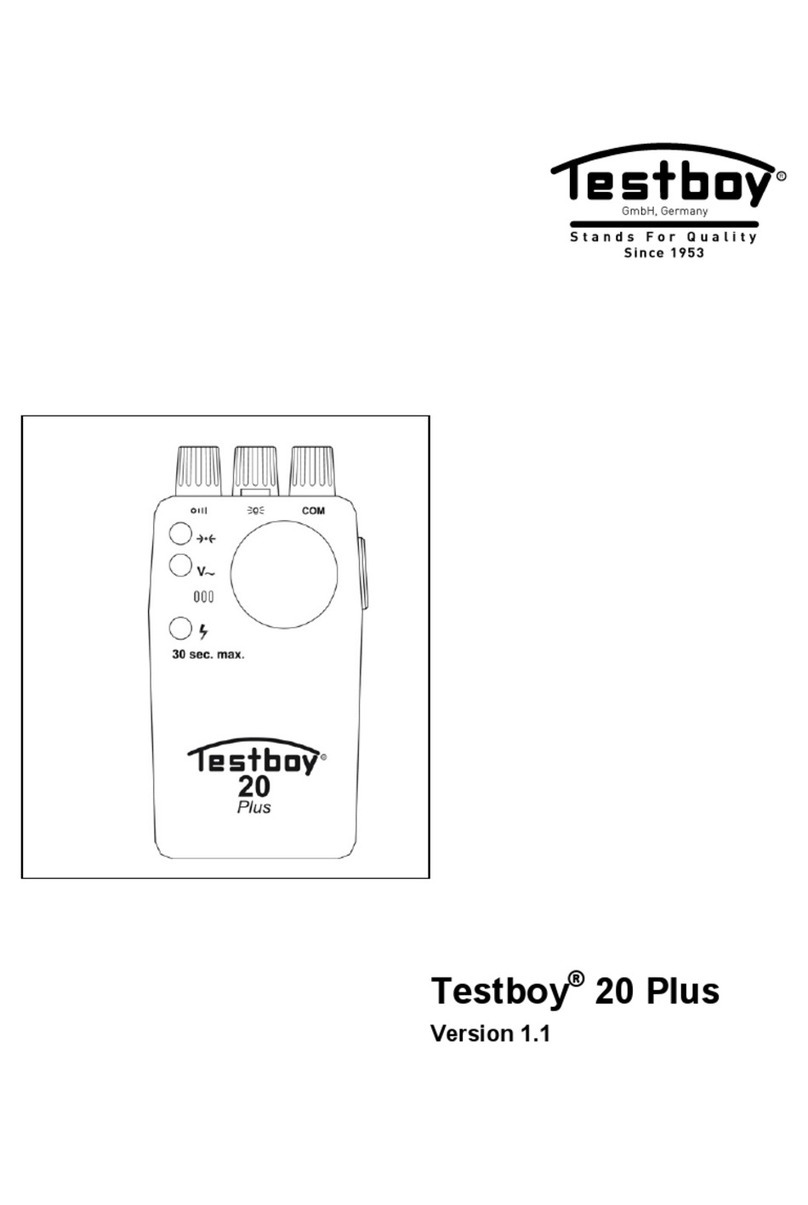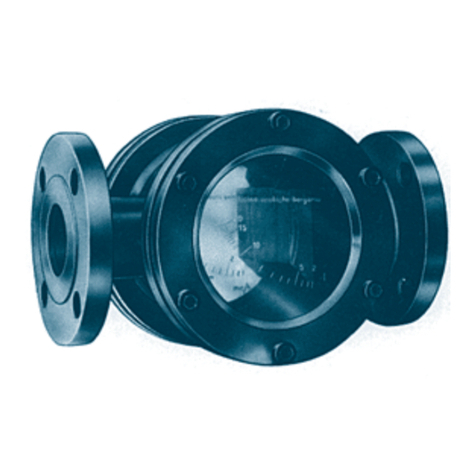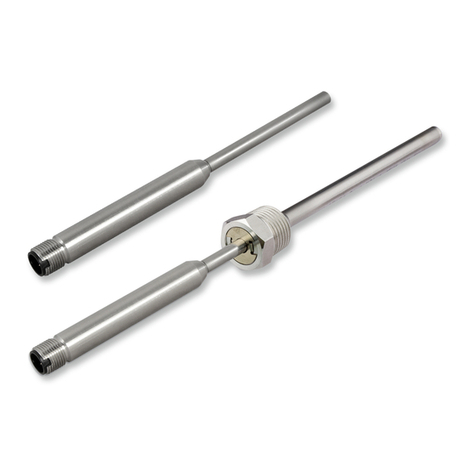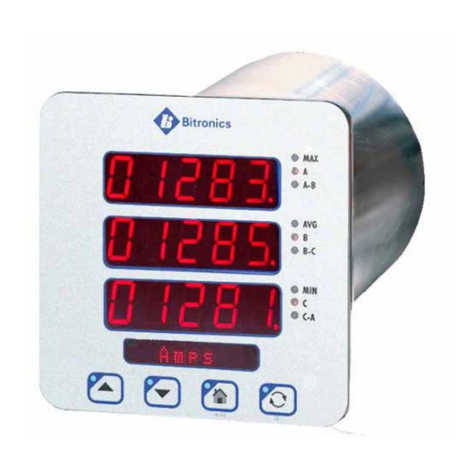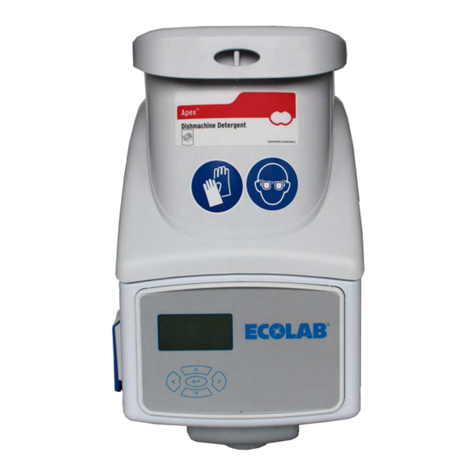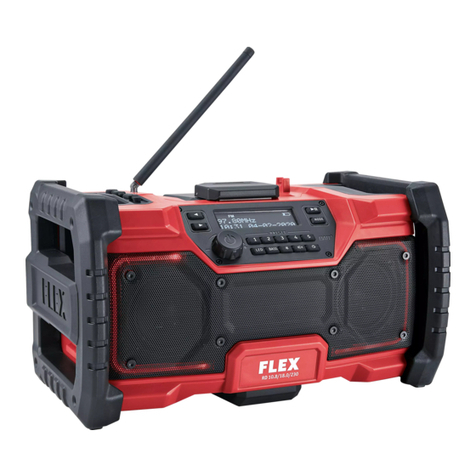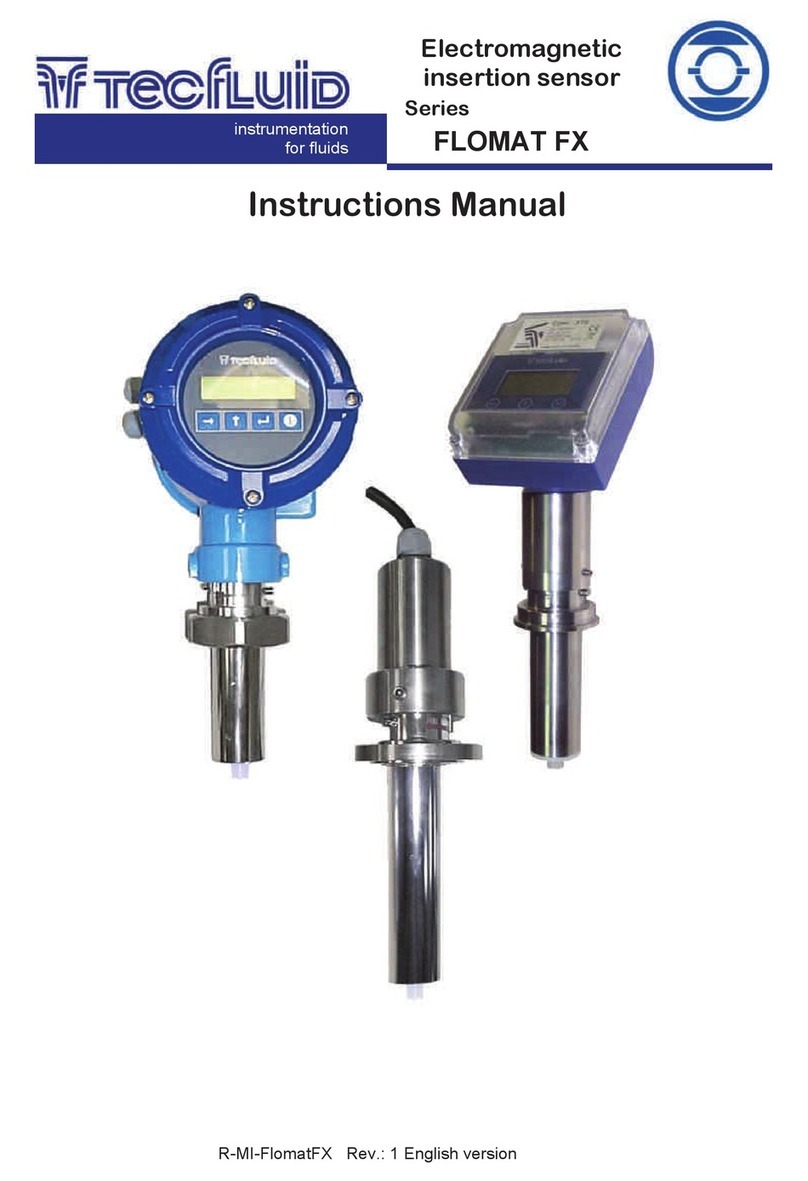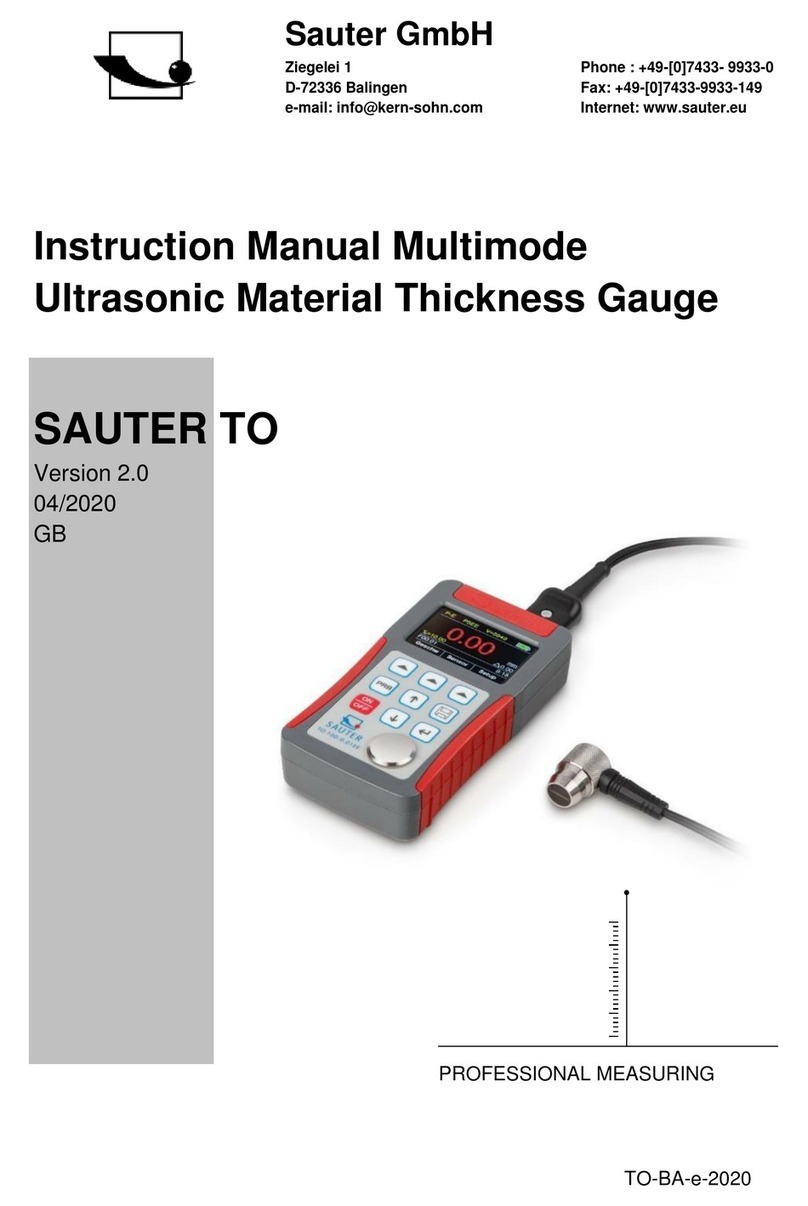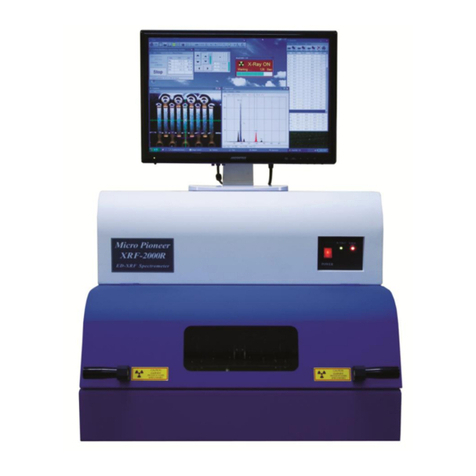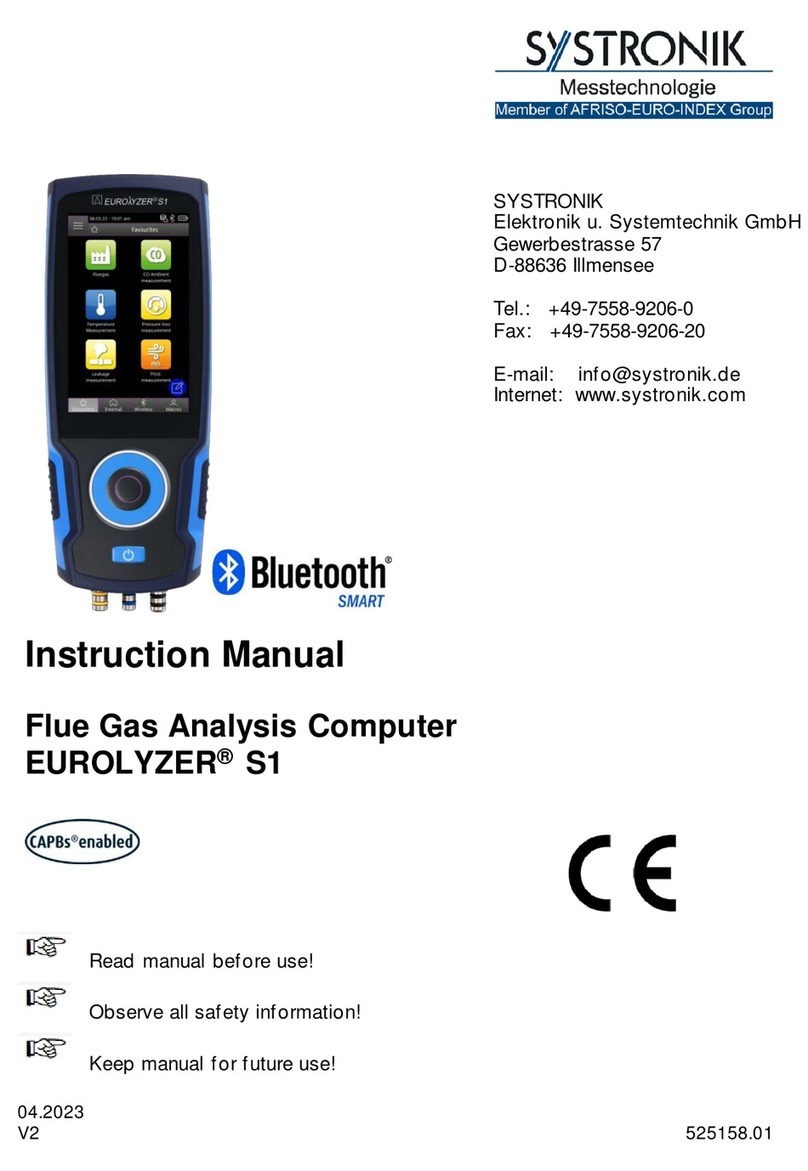Delta HD2114.0 User manual

Our instruments' quality level is the results of the product continuous development. This
can bring about differences between the information written in this manual and the
instrument that you have purchased. We cannot entirely exclude errors in the manual, for
which we apologize.
The data, figures and descriptions contained in this manual cannot be legally asserted. We
reserve the right to make changes and correction without prior notice.
HD2114.0-HD2114.2
HD2134.0-HD2134.2
HD2164.0-HD2164.2
HD2114B.0-HD2114B.2
ENGLISH
REV. 2.2
02/07/2014

- -
2
CONTENTS
INTRODUCTION ............................................................................................................................................................3
KEYBOARD AND MENU DESCRIPTION..................................................................................................................8
THE PROBES.................................................................................................................................................................14
PP471 MODULE FOR PRESSURE MEASUREMENT ............................................................................................................15
DIRECT INPUT INTO Pt100, Pt1000 AND Ni1000TEMPERATURE PROBES......................................................................15
How to measure.......................................................................................................................................................15
Instructions to connect the TP47 connector for 4-wire Pt100, Pt1000 and Ni1000 probes.....................................16
Direct connection of 4-wire Pt100 sensors..............................................................................................................17
WARNINGS AND OPERATING INSTRUCTIONS..................................................................................................18
INSTRUMENT SIGNALS AND FAULTS ..................................................................................................................19
LOW BATTERY WARNING AND BATTERY REPLACEMENT .........................................................................21
INSTRUMENT STORAGE...........................................................................................................................................22
SERIAL INTERFACE AND USB.................................................................................................................................23
STORING AND TRANSFERRING DATA TO A PERSONAL COMPUTER........................................................25
THE LOGGING FUNCTION -ONLY FOR HD21...4.2.........................................................................................................25
CLEARING THE MEMORY -ONLY FOR HD21...4.2..........................................................................................................25
THE PRINT FUNCTION -ONLY FOR HD21...4.2 ............................................................................................................26
CONNECTION TO A PC..............................................................................................................................................27
CONNECTION TO THE RS232C SERIAL PORT OF THE INSTRUMENT -ONLY FOR HD21…4.2..........................................27
CONNECTION TO THE USB 2.0 PORT OF THE INSTRUMENT -ONLY FOR HD21…4.2......................................................27
NOTES ABOUT WORKING AND OPERATIVE SAFETY .....................................................................................28
INSTRUMENT TECHNICAL CHARACTERISTICS...............................................................................................29
TECHINAL DATA OF PROBES AND MODULES IN LINE WITH THE INSTRUMENT ................................................................31
Pressure measurement by module PP471................................................................................................................31
Pt100 sensor temperature probes using SICRAM module......................................................................................32
4-wire Pt100 and 2-wire Pt1000 Probes without SICRAM module........................................................................33
ORDER CODES.............................................................................................................................................................34

- -
3
INTRODUCTION
This manual describes the characteristics and operating modes of the HD2114.0, HD2134.0,
HD2164.0 micromanometers, the HD2114B.0 barometer, and the corresponding HD2114.2,
HD2134.2, HD2164.2 and HD2114B.2 models with datalogger function. They are portable
instruments with a large LCD display. They perform measurements of absolute, relative and
differential pressure, and temperature.
Pressure is measured using an internal differential module that compares the atmosphere with
bottom of a fixed scale. With the PP471 module acting as an interface, the instrument can use all
the TP704 and TP705 series Delta Ohm probes to perform the measurements. The HD2114B.0 and
HD2114B.2 internal module measures the barometric pressure.
The temperature is detected using immersion, penetration, contact or air probes, with SICRAM
module or direct 4-wire probes. The sensor can be a Pt100, Pt1000 or Ni1000. The temperature
probes are fitted with a SICRAM module, with the factory calibration settings already being
memorized inside. On being turned on the instrument automatically detects these settings.
The HD2114.2, HD2134.2, HD2164.2 and HD2114B.2 instruments are dataloggers. They
memorize up to 36,000 samples, which can be transferred from the instrument connected to a PC
via the RS232C serial port or USB 2.0 port. The storing interval, printing, and baud rate can be
configured using the menu.
The HD2114.2, HD2134.2, HD2164.2 and HD2114B.2 instruments can transfer via the RS232C
serial port the acquired measurements to a PC or to a portable printer in real time.
The Max, Min and Avg function calculates the maximum, minimum or average values. The Peak
function can be activated with external probes connected to the module PP471 and detects the
presence of pressure peaks. Other functions include the relative measurement REL, the HOLD
function, and the automatic turning off which can also be disabled.
The instruments have IP66 protection degree.
If not otherwise specified, this manual's descriptions are intended to be applicable to all
models.
The HD21...4.0 abbreviation indicates the models HD2114.0, HD2134.0, HD2164.0, HD2114B.0,
and HD21...4.2 abbreviation indicates the models HD2114.2, HD2134.2, HD2164.2 and
HD2114B.2.
HD2114.0
HD2134.0
HD2164.0
HD2114B.0
HD2114.2
HD2134.2
HD2164.2
HD2114B.2
Full
scale
20mbar
200mbar
2000mbar
600..1100mbar
20mbar
200mbar
2000mbar
600..1100mbar
Barometer
-
-
-
YES
-
-
-
YES
Datalogger
-
-
-
-
YES
YES
YES
YES
RS232C-USB
-
-
-
-
YES
YES
YES
YES
External
power supply
-
-
-
-
YES
YES
YES
YES

- -
4
HD2114.0 - HD2134.0 - HD2164.0
Micromanometer - Thermometer
-----
HD2114B.0
Barometer - Thermometer

- -
5
HD2114.0 - HD2134.0 - HD2164.0 - HD2114B.0
1. Input, 8-pole DIN45326 connector. It is possible to connect: a PP471 SICRAM module, a
Pt100 temperature probe fitted with SICRAM module, a direct 4-wire Pt100 temperature probe,
a 2-wire Pt1000 probe or a 2-wire Ni1000 probe.
2. Positive input (+) into the internal pressure sensor. Quick coupling Ø 5mm
3. Battery symbol: displays the battery charge level.
4. Function indicators.
5. Secondary display line.
6. HOLD/key: freezes the measurement during normal operation; in the menu, increases the
current value.
7. FUNC/ENTER key: during normal operation displays the maximum (MAX), the minimum
(MIN) and the average (AVG) of current measurements; in the menu, confirms the current
selection.
8. REL/key: enables the relative measurement (displays the difference between the current
value and the logged value when the key is pressed); in the menu, decreases the current value.
9. PEAK key: starts and ends the peak measurement.
10. MENU key: allows access to and exit from the menu.
11. °C/°F-ESC key: changes the unit of measurement for temperature from degrees Celsius to
Fahrenheit; in the menu, cancels the operation in progress without making changes.
12. UNIT key: selects the unit of measurement for the pressure.
13. ON-OFF/AUTO-OFF key: turns the instrument on and off; when pressed together with the
HOLD key, disables the automatic turn off.
14. Peak, MAX, MIN and AVG symbols.
15. Main display line.
16. Multiplication factor -3, 3 or 6: the apex, if present, indicates that the displayed measurement
must be divided by 1000 (apex "-3"), multiplied by 1000 (apex "3") or by 1,000,000 (apex "6").
17. Line for symbols and comments.
18. Negative input (-) into the internal pressure sensor. Quick coupling Ø 5mm This input is not
present in the HD2114B.0 model.

- -
6
HD2114.2 - HD2134.2 - HD2164.2
Micromanometer - Thermometer
-----
HD2114B.2
Barometer - Thermometer

- -
7
HD2114.2 - HD2134.2 - HD2164.2 - HD2114B.2
1. Input, 8-pole DIN45326 connector. It is possible to connect: a PP471 SICRAM module, a
Pt100 temperature probe fitted with SICRAM module, a direct 4-wire Pt100 temperature probe,
a 2-wire Pt1000 probe or a 2-wire Ni1000 probe.
2. Positive input (+) into the internal pressure sensor. Quick coupling Ø 5mm
3. External auxiliary power supply connector input (positive at centre).
4. Battery symbol: displays the battery charge level.
5. Function indicators.
6. Secondary display line.
7. HOLD/key: freezes the measurement during normal operation; in the menu, increases the
current value.
8. FUNC/ENTER key: during normal operation displays the maximum (MAX), the minimum
(MIN) and the average (AVG) of current measurements; in the menu, confirms the current
selection.
9. REL/key: enables the relative measurement (displays the difference between the current
value and the logged value when the key is pressed); in the menu, decreases the current value.
10. SERIAL/ERASE LOG key: starts and ends the data transfer to the serial communication port.
In the menu, clears the data contained in the instrument's memory.
11. LOG/DUMP LOG key: during normal operation, starts and ends the saving of the data in the
internal memory; in the menu, starts the data transfer from the instrument's memory to the PC.
12. Mini-USB type B connector for USB 2.0. For the connection to PC (with cable CP23).
13. PEAK/MENU key: during normal operation, starts and ends the peak measurement. When
pressed together with the FUNC/ENTER key, allows access to the menu. To exit the menu,
press the key again.
14. C°/F°-ESC key: changes the unit of measurement for temperature from degrees Celsius to
Fahrenheit; in the menu, cancels the operation in progress without making changes.
15. UNIT key: selects the unit of measurement for the pressure.
16. ON-OFF/AUTO-OFF key: turns the instrument on and off; when pressed together with the
HOLD key, disables the automatic turn off.
17. Peak, MAX, MIN and AVG symbols.
18. Main display line.
19. Multiplication factor -3, 3 or 6: the apex, if present, indicates that the displayed measurement
must be divided by 1000 (apex "-3"), multiplied by 1000 (apex "3") or by 1,000,000 (apex "6").
20. Line for symbols and comments.
21. 8-pole MiniDin connector for RS232C. For the connection to PC (with cable HD2110CSNM or
C206) or printer (with cable HD2110CSNM).
22. Negative input (-) into the internal pressure sensor. Quick coupling Ø 5mm. This input is not
present in the HD2114B.2 model.

- -
8
KEYBOARD AND MENU DESCRIPTION
Foreword
The instrument keyboard is composed of single-function keys, like the UNIT key, and double-
function keys such as the ON-OFF/Auto-OFF key.
In the double-keys, the function in the upper part is the “main function”, while the one in the bottom
part is the “secondary function”. When the instrument is in standard measurement mode, the main
function is active. In the menu or in conjunction with the FUNC key, the secondary function is
enabled.
The pressing of a key is accompanied by a short confirmation beep: a longer beep sounds if the
wrong key is pressed.
Note: the instrument is fitted with internal pressure sensor with a fixed full scale. If a SICRAM
PP471 module with TP704 or TP705 probe is connected, the internal sensor is disabled and
the display indicated pressure is that of the external probe.
All operations described below and relevant to pressure measurement, therefore apply to the
internal sensor unless the external PP471 module is connected. Please see the paragraph
dedicated to calibration on page 14.
Each key specific function is described in detail below.
ON-OFF/Auto-OFF key
The instrument is turned on and off using the ON/OFF key. The turning on enables all display
segments for a few seconds, starts an auto-test including the detection of the possible probe
connected to the input, and sets the instrument ready for normal measurement. During the auto-test,
the serial number of the connected probe is indicated in the comment line: e.g.
"PRB1_SER_1234_5678" means the probe with serial number 12345678 is connected to the input.
If no probe is connected to central input, the "NO_PRBE_ SER_NUM" message appears for
a few seconds in the line for symbols.
When the probe is inserted into a functioning instrument, the "NEW_PROB_DET" (New
probe detected) message appears: as the probe's data are captured upon turning the
instrument on, it is necessary to turn the instrument off and on again.
Replace the probes when the instrument is off.
MIN
cm
min s
2
3
mµ
m
k
>>>

- -
9
+
Automatic turning off
The instrument has an AutoPowerOff function that automatically turns the instrument off after about
8 minutes if no key is pressed during the intervening time. The AutoPowerOff function can be
disabled by holding the HOLD key pressed down when turning the instrument on: the battery
symbol will blink to remind the user that the instrument can only be turned off by pressing the
<ON/OFF> key.
The automatic turning off function for the HD21...4.2 models is disabled when external power
is used. On the other hand, it cannot be disabled when the batteries are discharged.
FUNC/ENTER key
During normal measurement this enables the display of the maximum (MAX), minimum (MIN) and
average (AVG) value of the measurements captured by the instrument, updating them with the
acquisition of new samples. The acquisition frequency is once a second.
The MAX, MIN and AVG calculation begins upon turning on and is updated when the instrument
is in normal measurement mode. To reset the previous values and restart with a new measurement
session, press FUNC until the message “FUNC CLR” appears, then use the arrows to select YES
and confirm using ENTER.
In the menu, the ENTER key confirms the current parameter and then goes to the next one. Pressed
together with the PEAK/MENU key, opens the menu (please see the PEAK/MENU key
description).
Attention: the data captured using the Record function cannot be transferred to the PC.
HOLD/key
It increases the current parameter when used in the menu; when used in measurement mode, it
freezes the measurement in progress, and upon application of pressure on the key, the message
HOLD appears in the upper side of the display. To return to the current measurement, press the
key again.
Upon turning on the instrument, the AutoPowerOff function can be disabled by holding the HOLD
key down (please see the ON-OFF key description).
UNIT key
In measurement mode, it allows selection of the unit of measurement of the pressure (shown in the
central line of the display). By repeatedly pressing the key, the different units of measurement are
displayed in sequence: Pa, hPa, kPa, mbar, bar, atm, mmHg, mmH2O, kgf/cm2, PSI, inchHg.
This setting changes the information displayed and, only for the HD21...4.2 models, also the
immediate print of data (SERIAL key). The data recorded using the LOG function (HD21...4.2)
keep the chosen unit of measurement displayed during logging.
The unit of measurement associated with the data sent to the printer or PC through the serial
port using the SERIAL function (HD21...4.2), must be selected before starting the print function.

- -
10
°C/°F - ESC key
Changes the unit of measurement for the temperature between Centigrade or Fahrenheit.
When used in the menu, it clears or cancels the active function.
REL/key
In measurement mode, it displays the difference between the current value and that measured on
pressing the key for both measurements - main and secondary. The REL message appears on the
display; press the key again to return to the current measurement.
When used in the menu, it decreases the current variable value.
MENU key - only HD21...4.0
+
PEAK/MENU key - only HD21...4.2
The first menu item is accessed by initially pressing on the MENU key (FUNC/ENTER +
PEAK/MENU in the HD21...4.2 models); press ENTER to go to the following items. To modify the
item displayed, use the arrow keys (and ). The current value is confirmed by pressing the
ENTER key and the display moves on to the next parameter. If pressing ESC the setting is
cancelled.
To exit the menu, press the MENU or the PEAK/MENU key at any time.
The menu items are listed in this order:
1) Differential probes resetting: In the differential probes there can be a slight difference
between the two inputs, so the instrument does not indicate zero at comparable pressure
applied to the two inputs of a probe. This is the reason the reset command was designed for
the differential value: leave the inputs of each probe open so that they detect the same
pressure and enter the menu. The "PRES_REL_TO_ZERO ENTR_TO_MENU" message
appears: press REL to reset the difference or press ENTER to access other menu items. The
reset operation is applied to the internal pressure sensor if no differential probe
(TP705) is connected to the input.
2) Pressure probe full scale: the full scale and the enabled pressure probe type is presented.
3) Probe type: the message “>>>_PRBE_TYPE" is scrolled in the comment line. The main
line in the center of the display shows the type of temperature probe connected to the
instrument.
It is possible to connect:
Pt100 temperature probes complete with SICRAM module
4-wire Pt100 probes complete with TP47 module
2-wire Pt1000 probes complete with TP47 module
2-wire Ni1000 probes complete with TP47 module

- -
11
Upon turning on the instrument automatically detects the probes fitted with SICRAM
module: the Probe Type menu item is configured by the instrument as AUTO and cannot be
modified by the user.
Upon turning on the temperature probes direct 4-wire Pt100, the Pt1000 and Ni1000 display
the message "NO_PRBE_SER_NUM". In this case the probe type must be entered
manually. Select Probe type using the MENU key and then select the type of probe with
the arrow keys; confirm using ENTER.
4) Management of memorized data (only HD21...4.2): the message
“>>>_LOG_DUMP_or_ERAS” (Transfer data or erase) is scrolled in the comment line.
The center figure reports the number of free memory pages (FREE). Pressing
SERIAL/EraseLOG permanently erases all memory data. By pressing LOG/DumpLOG, the
data transfer of the logged data on the serial port is started: the “BAUD-RATE” must have
previously been set to the maximum value (please see the menu items described below and
the paragraph "STORING AND TRANSFERRING DATA TO A PERSONAL
COMPUTER" on page 25).
5) Print and log interval (only HD21...4.2): sets the interval in seconds between two loggings
or data transfers to the serial port. The interval can be set at 0, 1s, 5s, 10s, 15s, 30s, 60s
(1min), 120s (2min), 300s (5min), 600s (10min), 900s (15min), 1200s (20min), 1800s
(30min) and 3600s (1hour). If the value 0 is set, SERIAL works on command: the
sending of data to the serial port is performed each time the key is pressed. Recording
(LOG) is performed with one-second intervals even if the interval is set to 0. With an
interval from 1 to 3600s, continuous data transfer is started when the SERIAL key is
pressed. To end the recording (LOG) and continuous data transfer operations (SERIAL with
an interval greater than 0), press the same key again.
6) Sleep_Mode_LOG (Automatic turning off during recording) (only HD21...4.2): this
function controls the instrument's automatic turning off during logging, occurring between
the capture of a sample and the next one. When the interval is lower than 60 seconds, the
instrument will always remain on. With intervals greater than or equal to 60 seconds, it is
possible to turn off the instrument between loggings: it will turn on at the moment of
sampling and will turn off immediately afterwards, thus increasing the battery life. Using the
arrows select YES and confirm using ENTER in order to enable the automatic turning off,
select NO and confirm to disable it and keep the instrument on continuously.
Note: even if Sleep_Mode_LOG=YES is selected, the instrument does not turn off for less
than one minute intervals.
7) YEAR (only HD21...4.2): to set the current year. Use the arrows to modify this parameter
and confirm using ENTER.
8) MNTH (month) (only HD21...4.2): to set the current month. Use the arrows to modify this
parameter and confirm using ENTER.
9) DAY (only HD21...4.2): to set the current day. Use the arrows to modify this parameter and
confirm using ENTER.
10) HOUR (only HD21...4.2): to set the current hour. Use the arrows to modify this parameter
and confirm using ENTER.
11) MIN (only HD21...4.2): to set the current minutes. In order to correctly synchronize the
minute, it is possible to reset the seconds by pressing the UNIT key. Use the arrows to set
the current minute plus one, and as soon as that minute is reached press UNIT: this
synchronizes the time to the second. Press ENTER to go onto the next item.

- -
12
12) BAUD_RATE (only HD21...4.2): indicates the frequency used, expressed in kHz, for the
serial communication with the PC. Values from 1.2 (1200 baud) to 38.4 (38400baud). Use
the arrows to modify this parameter and confirm using ENTER. The communication
between instrument and PC (or serial port printer) only works if the instrument and
PC baud rates are the same. If the USB connection is used this parameter value is
automatically set (please see the details on page 25).
PEAK key - only HD21...4.0
PEAK/MENU key - only HD21...4.2
The PEAK (HD21...4.0) or PEAK/MENU (HD21...4.2) keys enable the pressure peak measurement
circuit. The Peak indication blinks and the current pressure is shown. When a peak is detected (a
positive variation greater than 5% compared to current measurement), the Peak indication remains
on for 5 seconds and its value is displayed. If, in the meantime, a higher peak than the previous one
is detected, the indication is updated. From 5 seconds after the previously detected peak, the Peak
indication returns to blinking and the current pressure is shown.
To keep the maximum peak on the display, select the peak function and then the record MAX
function using FUNC/ENTER. This way, the display continuously shows the maximum peak
reached during measurement. Before starting new measurements, clear the memory of previous
measurements using "FUNC CLR": please see the FUNC/ENTER key description.
IMPORTANT: the peak measurement works with external probes connected to the
instrument through a SICRAM PP471 module and not with the internal pressure sensor.
The Logging function during peak measurement (only HD21...4.2):
To record the maximum peaks, start the peak function and then the record function (LOG key). As
the measured peak is maintained for about 5 seconds, in order to avoid losing any peak, use 1
second logging intervals. Indeed, using longer times the single event could occur between two
subsequent recording and be ignored.
LOG/DUMP LOG key - only HD21...4.2
In measurement mode, this function starts and stops the logging of a data block to be saved in the
instrument's internal memory. The data logging frequency is set in the "Print and log interval"
menu parameter. The data logged between a start and subsequent stop represent a block.
When the logging function is on, the LOG indication is displayed, the battery symbol blinks and a
beep is issued each time a logging occurs; the battery symbol does not appear when using an
external power supply.
To end the logging, press LOG.
The HD21...4.2 can turn off during logging between one capture and the next: the function is
controlled by the Sleep_Mode_LOG parameter. When the logging interval is less than one minute,
the logging instrument remains on; with an interval of at least one minute, it turns off between one
capture and the next if the parameter Sleep_Mode_LOG=YES.

- -
13
[
+
]
>>>
Dump LOG - only HD21...4.2
To start the transfer of the data contained in the instrument internal memory via the serial port, press
simultaneously the FUNC/ENTER and PEAK/MENU keys, using ENTER select the
“>>>_LOG_DUMP_or_ERAS” item, and then press on the LOG/DumpLOG key.
Please see the paragraph dedicated to data transfer on page 25.
SERIAL/EraseLOG key - only HD21...4.2
In measurement mode, this function starts and stops the data transfer to the serial output.
According to the settings entered in the Print and log interval menu item, a single sample can be
printed if Print and log interval=0 or a continuous indefinite printing of the measured data can be
set up if Print and log interval=1…3600.
The printing operation is accompanied by the display of the RS232 symbol and the blinking of the
battery symbol; when using an external power supply the battery symbol does not appear.
Press SERIAL to end the continuous printing.
Before starting the printing via the RS232C port, set the baud rate. To do so, select the Baud Rate
menu item and select the maximum value equal to 38400 baud by using the arrows. Confirm by
pressing ENTER.
The DeltaLog9 software for PC will automatically set the baud rate value during connection. If you
are using a different program than DeltaLog9, be sure the baud rate is the same for both the
instrument and the PC: the communication will only work in this way.
The USB 2.0 connection does not require the baud rate setting as it is automatically managed by the
application.
[
+
]
>>>
Erase memory - only HD21...4.2
Press simultaneously the FUNC/ENTER and PEAK/MENU keys, using ENTER select the
“>>>_LOG_DUMP_or_ERAS” item, and then press on the SERIAL/EraseLOG key: this clears
permanently all the data contained in the instrument’s memory.

- -
14
THE PROBES
The HD21...4.0 and HD21...4.2 instruments are fitted with differential pressure sensor
compared to the atmosphere of 20mbar (models HD2114), 200mbar (models HD2134) and
2000mbar (models HD2164). The HD2114B.0 and HD2114B.2 models measures the barometric
pressure in the 600…1100mbar range.
The coupling on the left is positive (+), on the right negative (-): for relative measurements
compared to atmosphere, apply the pressure to the positive input and leave the negative input open.
Important: the nominal bottom scales of internal sensors (20, 200, 2000mbar and 1100mbar)
are referred to atmospheric pressure,therefore on each of these inputs no relative pressure
exceeding the maximum stated overpressure should be applied. Each of the two sensor inputs can
bear without breaking–but without measuring–the overpressures reported in the following table:
HD2114.0
HD2114.2
HD2134.0
HD2134.2
HD2164.0
HD2164.2
HD2114B.0
HD2114B.2
Measurement range
20mbar
200mbar
2000mbar
600..1100mbar
Maximum overpressure
300mbar
1bar
6bar
3bar
In addition to the internal sensor, it is possible to measure absolute, relative and differential pressure
using the PP471 SICRAM module and the TP704 and TP705 series probes. The peak measurement
is enabled using these probes.
To change the instantaneous or peak value unit of measurement, press UNIT. The following units of
measurement are available:
Pa, hPa, kPa, mbar, bar, atm, mmHg, mmH2O, kgf/cm2, PSI, inchHg.
Some units of measurement require a multiplication factor: the “-3” symbol indicates the displayed
value must be divided by 1,000; the "3" and "6" symbols indicate the displayed value must be
multiplied respectively by 1,000 or by 1,000,000.
All models measure also the temperature using probes fitted with SICRAM module and with
temperature probes with 4-wire Pt100, 2-wire Pt1000 or Ni1000 sensors.
In the probes fitted with SICRAM module the latter acts as an interface between the sensor on the
probe and the instrument. There is a microprocessor circuit with a permanent memory inside the
module that enables the datalogger to recognize the type of probe connected and to read its
calibration information.
The temperature probes without SICRAM module are not automatically detected by the instrument
and must be set up in the Probe type menu item (please see the description of the menu on page
10).
The probes are detected during turn on, and this cannot be performed when the instrument is
already on, therefore if a probe is connected and the instrument is on, it is necessary to turn it
off and on.
The probes are fitted with SICRAM module are calibrated in the factory; no calibration is required
by the user.

- -
15
PP471 MODULE FOR PRESSURE MEASUREMENT
The PP471 module acts as an interface between the TP704 and TP705 series Delta Ohm probes and
the instrument.
The TP704 series pressure probes have a 1/4” BSP threaded male connection and must be screwed
in the joint where you wish to measure the pressure. The TP 705 series have two Ø5 connections
where the suitable tubes are inserted in order to perform the desired measurement. Please pay
careful attention to the joint pressure sealing; use suitable gaskets and joints. A plastic cap protects
the threaded connection. Put it back after use as it protects the pressure cell from foreign bodies.
VERY IMPORTANT: ensure the probe's bottom scale is higher than the pressure that will be
measured. In case this value is unknown, start by using higher-capacity probes.
For every pressure probe a range of overload pressure and a burst pressure are declared:
pressures in the range of overload pressure don’t cause the break of the sensor but the
declared accuracy can be overcome. Pressure over the stated burst pressure may break the
sensor. The application of higher pressures than the overload pressure limit, although lower
than the burst pressure, may produce permanent damage to the probe (e.g. offset shift). Never
exceed the stated burst pressure.
Please see the technical characteristics of the probes on page 31.
Upon turning on the instrument automatically detects the PP471 module. The probe's type
(absolute, relative or differential) and bottom scale value are detected even when the instrument is
on. If no logging or recording operations are in progress, it is possible to change the probe
connected to the module without turning the instrument off and on again.
The measurement provided can be the instantaneous or the peak value of the pressure: please see
the PEAK key description on page 12.
When the PP471 pressure module is connected, the internal sensor is disabled.
DIRECT INPUT INTO Pt100, Pt1000 AND Ni1000 TEMPERATURE PROBES
The instrument accepts the input of Platinum temperature probes with resistances of 100Ω and
1000Ω, as well as Nickel temperature probes with a 1000Ω resistance.
The Pt100 are connected to 4 wires, the Pt1000 and Ni1000 to 2 wires, with the excitation current
chosen minimizing the sensor self-heating effects.
All probes with module are calibrated in the factory, the 2 or 4-wire probes with direct input are
checked for conformity with class A tolerance according to norm IEC751 - BS1904 - DIN43760.
For the temperature probes without SICRAM module (Pt100 4 wires, Pt1000 and Ni1000) the
model configuration is required (please see the description of the Probe Type menu on page 10).
The °C or °F unit of measurement can be chosen for display, printing, and logging using the °C/°F-
ESC key.
How to measure
The response time for the measurement of the temperature in air is greatly reduced if the air is
moving. If the air is still, stir the probe. Please remember that the response times in any case are
longer than those for liquid measurements.
The temperature measurement by immersion is carried out by inserting the probe in the liquid for at
least 60mm; the sensor is housed in the end part of the probe.

- -
16
In the temperature measurement by penetration the probe tip must be inserted to a depth of at least
60mm, the sensor is housed in the end part of the probe. When measuring the temperature on frozen
blocks it is convenient to use a mechanical tool to bore a cavity in which to insert the tip probe.
In order to perform a correct contact measurement, the measurement surface must be even and
smooth, and the probe must be perpendicular to the measurement plane.
So as to obtain the correct measurement, the insertion of a drop of oil or heat-conductive
paste is useful (do not use water or solvents). This method also improves the response time.
Instructions to connect the TP47 connector for 4-wire Pt100, Pt1000 and Ni1000 probes
All Delta Ohm probes are provided with a connector. The HD21...4.0 and HD21...4.2 instruments
also work with direct 4-wire Pt100, Pt1000 and Ni1000 probes manufactured by other producers;
for the instrument connection is prescribed the TP47 connector to which the probe's wires should be
welded.
The instructions to connect the Platinum or Nickel probe to the module are provided below.
The module is supplied complete with fairlead and gasket for 5mm maximum diameter cables.
Do the following to open the module and connect a probe:
Unscrew the fairlead and extract the gasket, remove the label using a cutter, unscrew the ring on the
opposite side as illustrated in the figure:
Open the two module shells: the printed circuit to which the probe must be connected is housed
inside. On the left there are the 1…4 points on which the sensor wires must be welded. The
JP1…JP4 jumpers are in the center of the board. These must be closed with a tin bead for some type
of sensors:
1
2
3
4
Pt100 3 wires
Pt1000
Ni1000
NotUsed
Before welding, pass the probe cable through the fairlead and gasket.

- -
17
Weld the wires as shown in the table:
Sensor
TP47 card connection
Jumper to close
Pt100 4 wires
4JP4
3JP3
1JP1
2 JP2
Pt100
4 wires
None
Pt1000 2 wires
JP4
4JP3
3
JP1
1JP22
Pt1000
2 wires
JP2
Ni1000
JP4
4JP3
3
JP1
1JP2
2
Ni1000
2 wires
JP3
Ensure the welds are clean and perfect. Once the welding operation is complete, close the two
shells, insert the gasket in the module, and screw the fairlead. At the other end of the module, enter
the ring with the O-Ring as indicated in the picture.
Make sure the cable is not twisted while you are screwing the fairlead. Now the probe is ready.
Direct connection of 4-wire Pt100 sensors
4-wire Pt100 sensors can be soldered
directly to the pins of the free female
connector without making use of the
TP47 board. The 4 wires of the Pt100
sensors have to be soldered as indicated
in the figure on the left.
In order to use this type of probe it is
necessary to set up the menu item “Probe
Type” as described at page 10.
The P100 probe is recognized upon
turning on the instrument: connect the
probe when the instrument is switched
off and then turn it on.
Sensor
Direct soldering to the connector
Pt100 4 wires
View of the soldering side
of the free female connector

- -
18
WARNINGS AND OPERATING INSTRUCTIONS
1. Do not expose the probes to gases or liquids that could corrode the material of the sensor or the
probe itself. Clean the probe carefully after each measurement. Some pressure probe model are
suitable for measurement of non corrosive gases or air and dry and not liquid only: check the
membrane compatibility with the plant fluid.
2. Do not bend the probe connectors or force them upward or downward. Do not bend or force the
contacts when inserting the probe connector into the instrument.
3. Do not bend, deform or drop the probes, as this could cause irreparable damage.
4. Always select the most suitable probe for your application.
5. Do not use probes in presence of corrosive gases or liquids. The sensor container is made of
AISI 316 stainless steel, while the contact probe container is made of AISI 316 stainless steel
plus silver. Avoid contact between the probe surface and any sticky surface or substance that
could corrode or damage it.
6. Above 400°C and below –40°C, avoid violent blows or thermal shocks to Platinum temperature
probes as this could cause irreparable damage.
7. To obtain reliable measurements, temperature variations that are too rapid must be avoided.
8. Temperature probes for surface measurements (contact probes) must be held perpendicular
against the surface. Apply oil or heat-conductive paste between the surface and the probe in
order to improve contact and reduce reading time. Whatever you do, do not use water or solvent
for this purpose. A contact measurement is always very hard to perform. It has high levels of
uncertainty and depends on the ability of the operator.
9. Temperature measurements on non-metal surfaces usually require a great deal of time due to the
low heat conductivity of non-metal materials.
10. Probes are not insulated from their external casing; be very careful not to come into contact
with live parts (above 48V). This could be extremely dangerous for the instrument as well
as for the operator, who could be electrocuted.
11. Avoid taking measurements in presence of high frequency sources, microwave ovens or large
magnetic fields; results may not be very reliable.
12. Clean the probe carefully after use. Clean the probe pressure chamber carefully. Avoid deposits
or incrustations left by the fluid coming into contact with the membrane, as with time this could
cause measurement errors.
13. Avoid inserting nails or spikes into the pressure chamber as the membrane could be
unintentionally torn.
14.In order to fix the probes, use a suitable fixed wrench, and possibly sealing gaskets.
15.Great attention must be paid while installing the probes in containers and tubes under
pressure. Also pay attention to the probes' bottom scale. In addition to the
irreparable damage, it can even cause serious physical damage to both the operator
and things. Before the probe a stop valve should always be present. Ensure that the
plant is not subject to abnormal or unexpected depressed fluid fluctuations.
16. The instrument is water-resistant and IP66, but is not watertight and therefore should
not be immersed in water without closing the free connectors using caps. The probe connectors
must be fitted with sealing gaskets. Should the instrument fall into the water, check for any
water infiltration. Gently handle the instrument in such a way as to prevent any water infiltration
from the quick couplings' side.

- -
19
INSTRUMENT SIGNALS AND FAULTS
The following table lists all error indications and information displayed by the instrument and
supplied to the user in different operating situations:
Display indications
Explanation
ERR
This appears if the PP471 module, a temperature or a pressure probe,
has already been detected by the instrument, but is disconnected.
PROB COMM LOST
This appears if the SICRAM module, has already been detected by the
instrument, but is disconnected. At the same time an intermittent beep
is issued.
OVER
Measurement overflow: indicates that the probe is measuring a value
exceeding the measuring range. For the pressure, the limit is set to
120% of the bottom scale nominal value.
LOG
MEM
FULL
Memory full; the instrument cannot store further data, the memory
space is exhausted.
NEW PROBE DET
This message appears when a probe is inserted into a functioning
instrument. Turn the instrument off and then back on again.
PROB
ERR
A probe with SICRAM module has been inserted when not admissible
for that specific instrument.
SYS
ERR
#
Instrument management program error. Contact the instrument's
supplier and communicate the numeric code # reported by the display.
CAL
LOST
Program error: it appears after turning on for a few seconds. Contact
the instrument's supplier.
BATT TOO LOW
CHNG NOW
Indication of insufficient battery charge appearing on turning on. The
instrument issues a long beep and turns off. Replace the batteries.

- -
20
The following table reports the indications provided by the instrument as they appear on the display,
together with their description.
Display indication
Explanation
### BAR ABS
probe ###bar absolute
### BAR DIFF
probe ###bar differential compared to atmosphere
### BAR GAUG
probe ###bar relative
### BAR SG
probe ###bar relative compared to 1 bar
### mBAR ABS
probe ###mbar absolute
### mBAR DIFF
probe ###mbar differential
### mBAR GAUG
probe ###mbar relative
>>>_LOG_DUMP_or_ERAS
transfer or erase data
>>>_PRBE_TYPE
type of probe connected
BATT TOO LOW - CHNG NOW
battery discharged - replace it immediately
BAUDRATE >>>
baud rate value
COMM STOP
printing complete
COMM STRT
printing started
DAY_
day
DUMP_END
data transfer complete
DUMP_In_PROG >>>
data transfer in progress
ERR
error
FUNC CLR
max, min and average values clearing
FUNC CLRD
max, min and average values cleared
HOUR
hour
LOG In PROG
logging in progress
LOG MEM FULL
memory full
LOG_CLRD
memory data cleared
LOG_STOP
logging complete
LOG_STRT
logging started
MIN >>> USE_UNIT_TO_ZERO SEC
minutes >>> use the UNIT key to reset the seconds
MNTH
month
NEW_PROB_DET
new probe detected
OVER
maximum limit of temperature or pressure exceeded
PLS_EXIT >>> FUNC RES_FOR_FACT ONLY
please exit using ESC >>> function reserved to factory
calibration
NO_PRBE_SER_NUM
the serial number of the probe connected to the input is absent
PRBE_SER #### ####
serial number #### #### of the probe connected to the input
PRES_REL_TO_ZERO ENTR_TO_MENU
press REL to reset differential probe or ENTER to access menu
PRNT AND LOG INTV
printing and logging intervals
PRNT INTV >>>
printing interval
PROB COMM LOST
lost communication with SICRAM module
PROB ERR
error - unexpected probe
SLP_MODE_LOG
turning off during recording mode
SYS ERR #
program error number #
YEAR
year
This manual suits for next models
7
Table of contents
Other Delta Measuring Instrument manuals
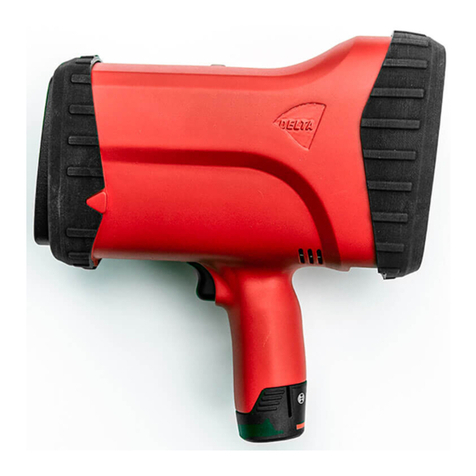
Delta
Delta RetroSign GRX-1 User manual

Delta
Delta HD2105.2 User manual

Delta
Delta RetroSign GR1 User manual
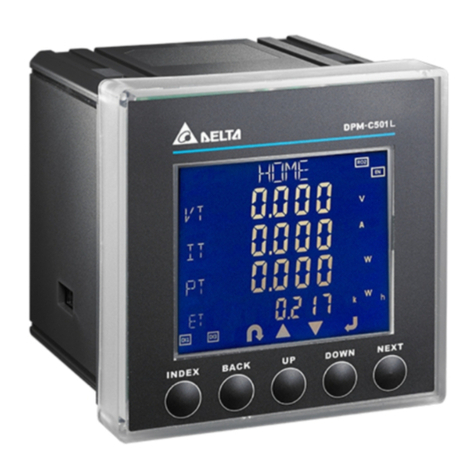
Delta
Delta DPM-C501L User manual
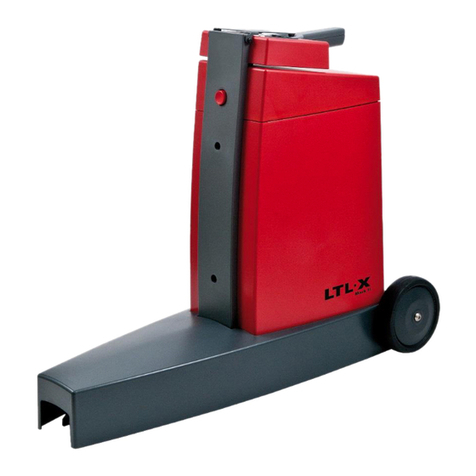
Delta
Delta LTL-X Mark II User manual
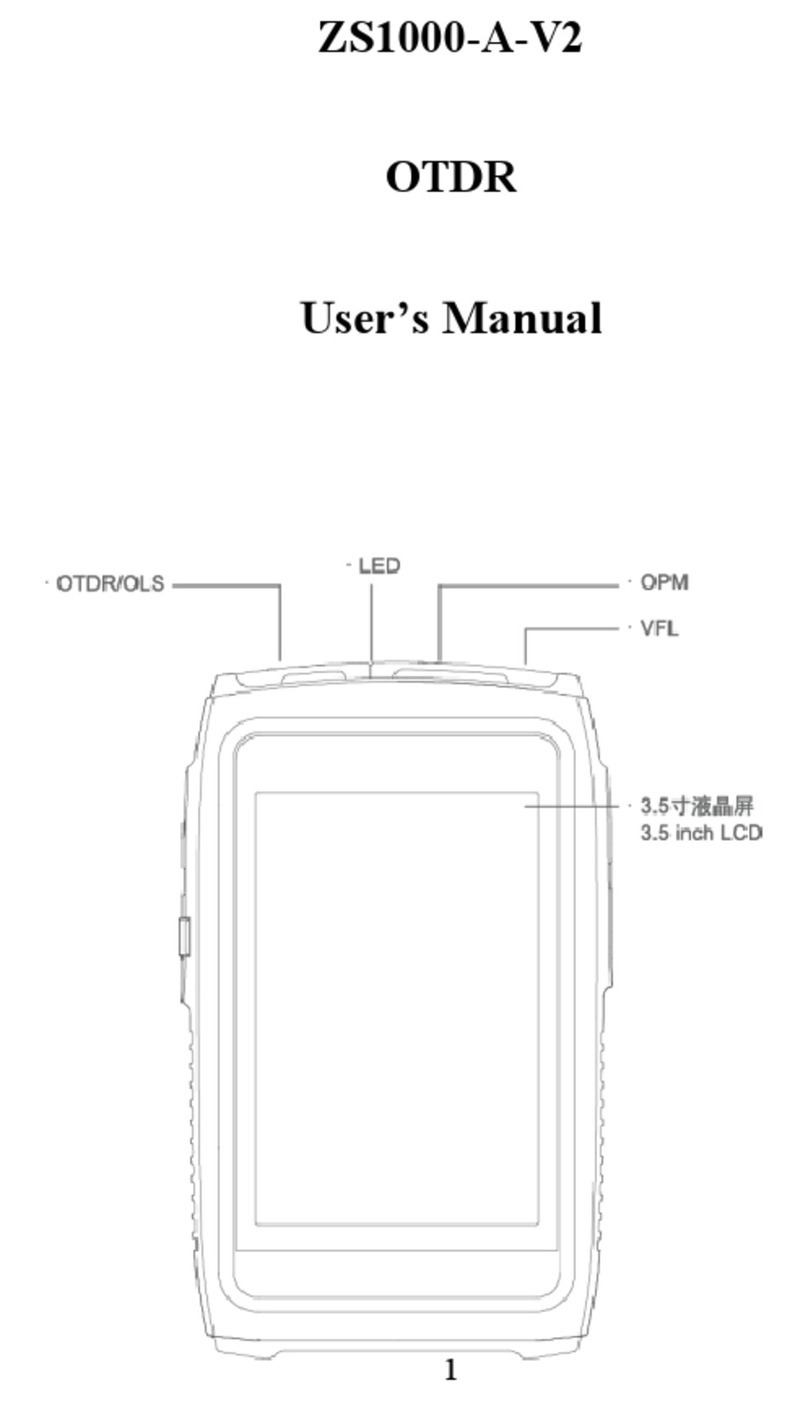
Delta
Delta ZS1000-A-V2 User manual
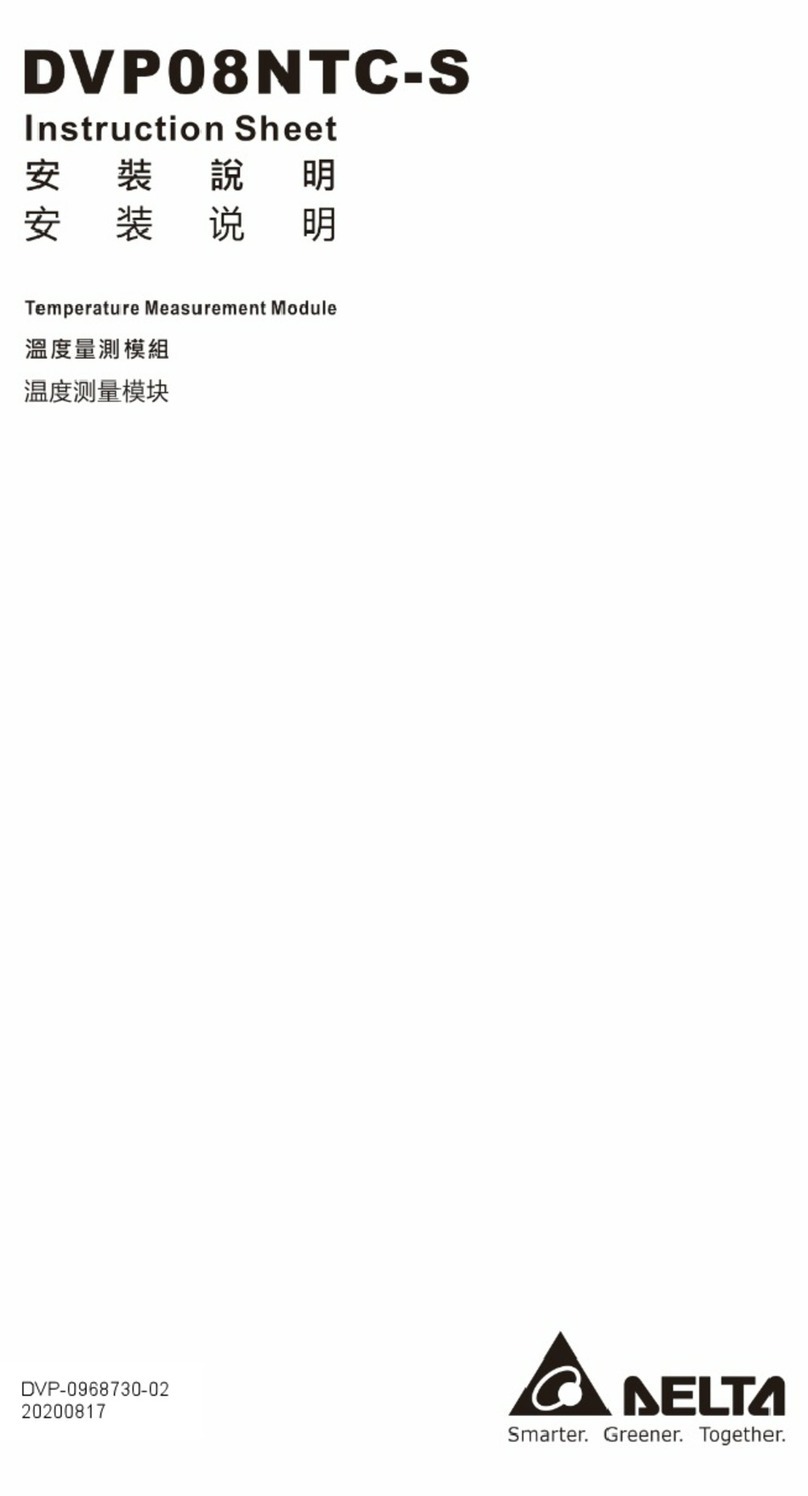
Delta
Delta DVP08NTC-S User manual
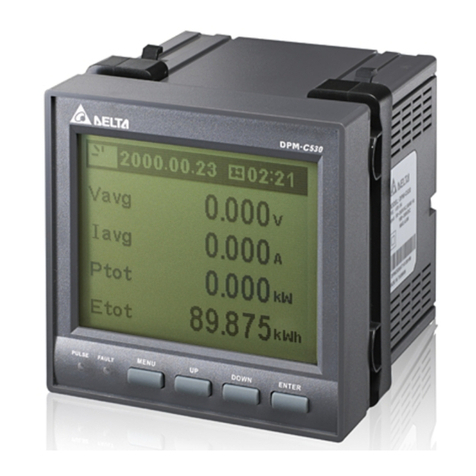
Delta
Delta DPM-C530 User manual
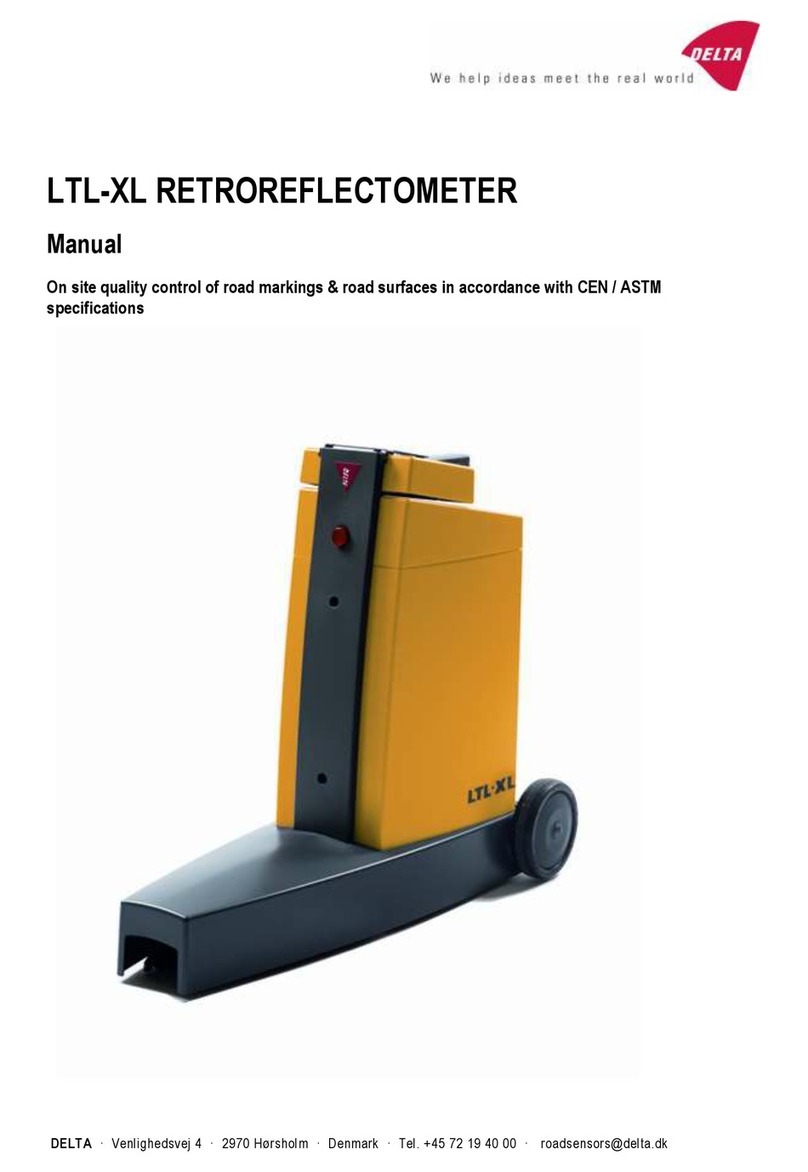
Delta
Delta LTL-XL User manual

Delta
Delta EMS 32-011 User manual
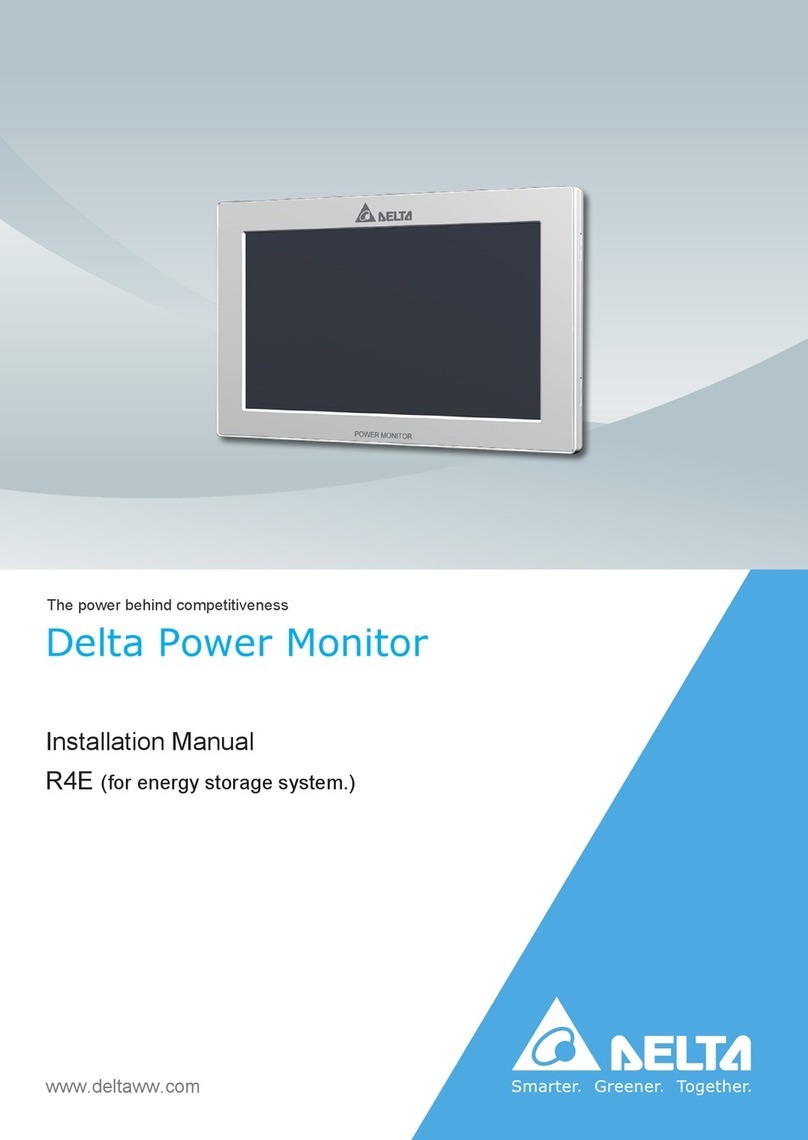
Delta
Delta R4E User manual

Delta
Delta WS-6975 User manual
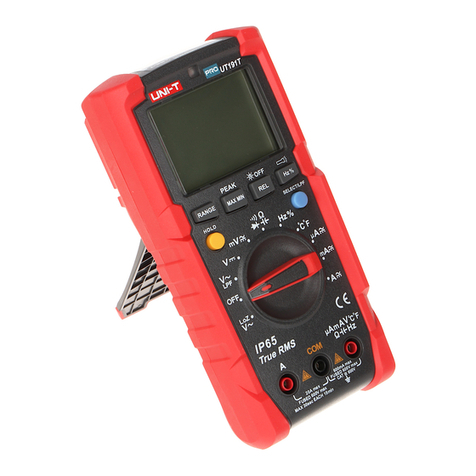
Delta
Delta UT-191T User manual
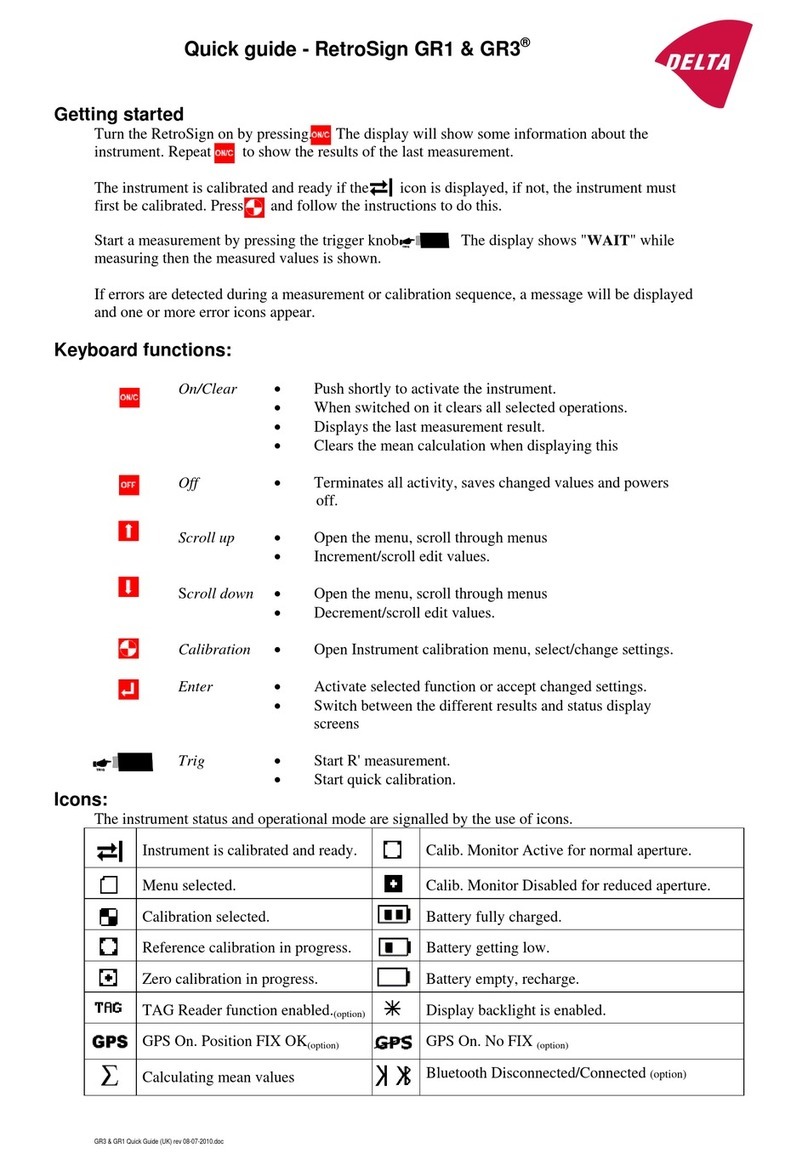
Delta
Delta RetroSign GR1 User manual
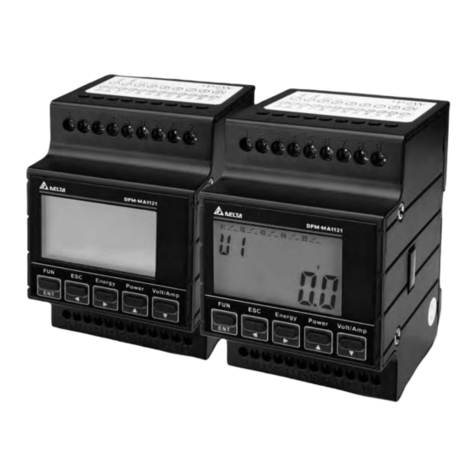
Delta
Delta DPM-MA1121 User manual
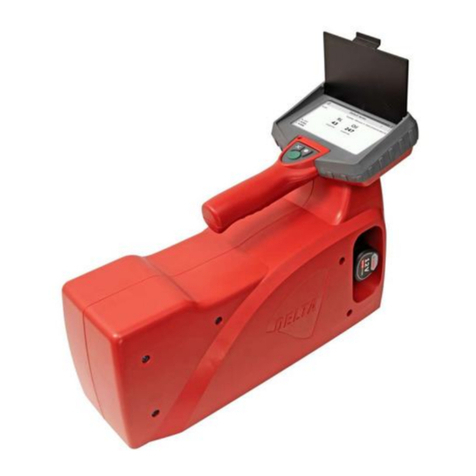
Delta
Delta LTL3000 User manual
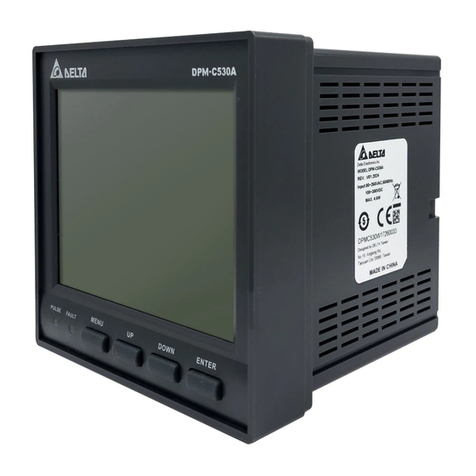
Delta
Delta DPM-C530A User manual
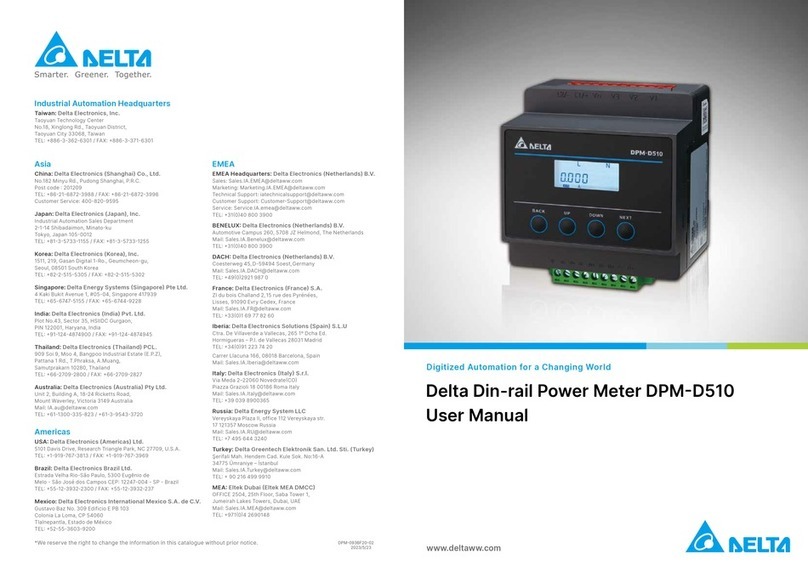
Delta
Delta DPM-D510 User manual

Delta
Delta TZU-22 User manual
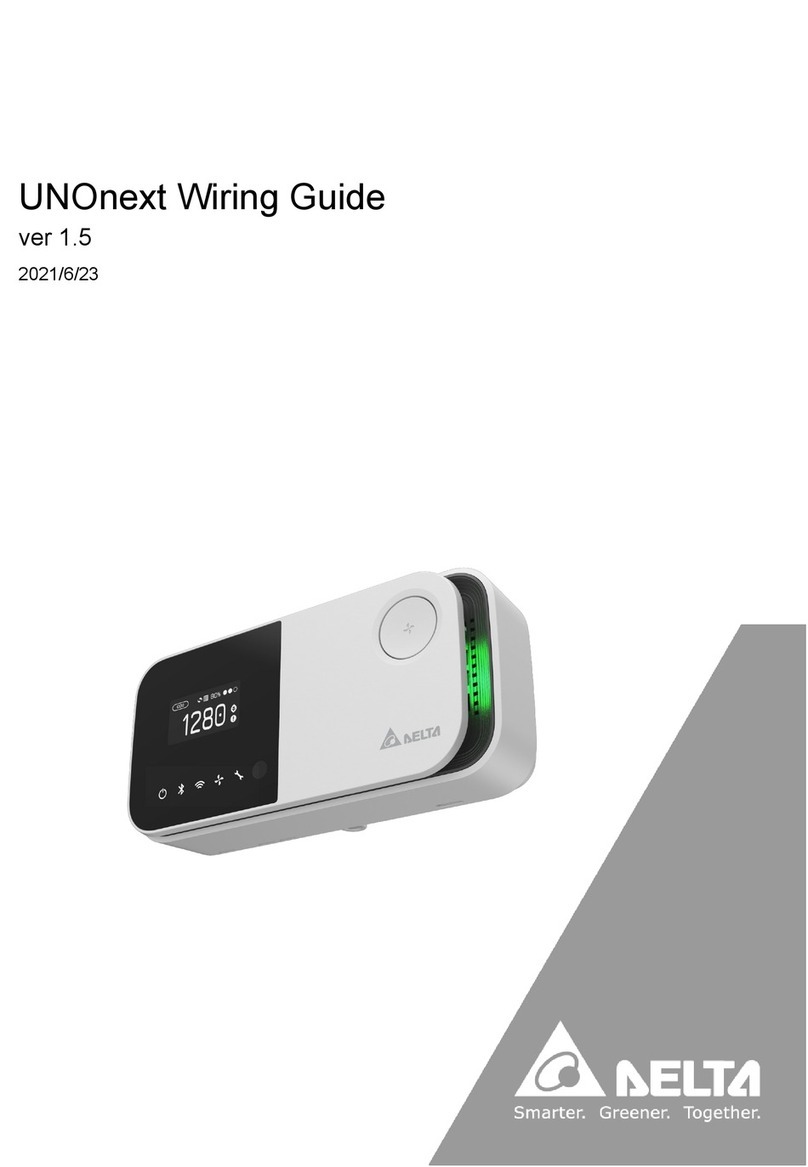
Delta
Delta UNOnext User manual
